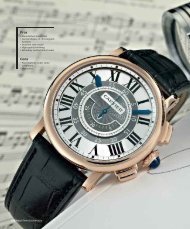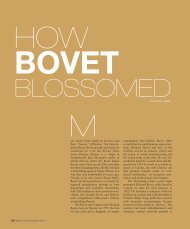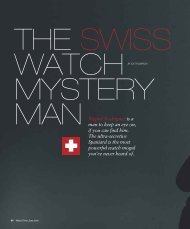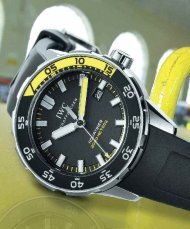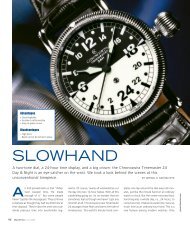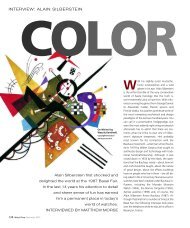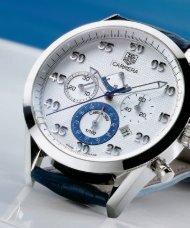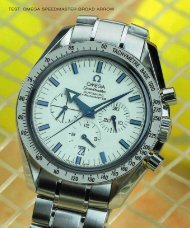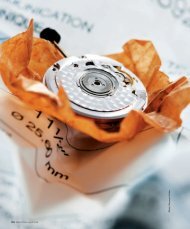patek philippe vs. a lange & soehne - Forums
patek philippe vs. a lange & soehne - Forums
patek philippe vs. a lange & soehne - Forums
- No tags were found...
Create successful ePaper yourself
Turn your PDF publications into a flip-book with our unique Google optimized e-Paper software.
Pros+ Beautiful, clean dial+ Superlative craftsmanship+ Good rate resultsCons– No exhibition caseback– No stop-seconds functionApril 2008 WatchTime 197
Pros+ Classically elegant design+ Outstandingly high-qualityworkmanship+ Exhibition casebackCons– Less than perfect rate results198 WatchTime April 2008
TESTPatek Philippe <strong>vs</strong>. A Lange & SöhneLANGE’S CALIBER L941.1 RECALLS GERMANWATCHMAKING TRADITION WITH A THREE-QUARTERS PLATE, SCREWED GOLDSETTINGS AND A SWAN’S NECK MECHANISM.SPECSA. LANGE & SÖHNE SAXONIAManufacturer: Lange Uhren GmbH, AltenbergerStrasse 15, D-01768 Glashütte,GermanyReference number: 215.029Functions: Hours, minutes, small seconds,stop-seconds functionMovement: Caliber L941.1, hand-wound,diameter = 25.6 mm, height = 3.2 mm,21,600 vibrations per hour, 21 jewels, Incablocshock absorption, swan’s neck fineadjustment mechanism, screw balance,screwed gold settings, hand-engravedbalance cock, 164 components, 45-hourpower reserveCase: White gold, sapphire crystals abovedial and in back, screwed back; water-resistantto 3 ATMStrap and clasp: Crocodile-skin strapwith white-gold pronged buckleRate results:(Deviations in seconds per 24 hours)Dial up: +1Dial down: 0Crown up: –3Crown down: +1Crown left: +8Crown right: +2Greatest deviation of rate: 11Average deviation: +1.5Average amplitude:flat positions: 288°hanging positions: 257°Dimensions: Diameter = 37 mm,height = 7.7 mm; weight = 66 gPrice: $15,100timepieces in the course of its illustrioushistory, including the world’s most complicatedpocket watches, which werebuilt on commission from the bankerHenry Graves. Patek Philippe was alsoamong the first brands to produce wristwatches.The Calibre 89 pocket watch,which debuted in 1989, has 33 functionsand remains the world’s most complicatedportable timepiece (roughly the size ofa grapefruit, it’s so large that the term“watch” seems like a misnomer).The two timepieces we tested are a farcry from the complicated creations forwhich both brands are famed. Each watchdisplays nothing but the time; each showsthe passing seconds on an off-center subdial;and each has indices rather than numerals.The bare-essentials appearance ofthe dial reflects the simplicity of the movements.Neither has a self-winding mechanism.Both are therefore able to fit in veryslim, elegant cases. Although the movementsstick strictly to the basics, both areelaborately decorated by hand. The casesand other visible components are also ofthe highest quality. In a nutshell, they representpure ticking luxury.BOTH WATCHES look to the past fortheir design inspiration. The Calatravareference 5196 bears the same final digitsas the original Calatrava, the reference 96from 1932. The reference 5196 borrowsits precursor’s dauphine hands, secondssubdial, faceted indices and wreath of tinydots forming the minute circle. The diameterof the 96 was significantly smaller, sothe rim of its seconds subdial was tangentto the periphery of the dial at 6 o’clock.It isn’t so easy to identify the Saxonia’sprecursor. A model with this namewas introduced at the brand’s rebirth in1994. Like the current model, the 1994Saxonia eschewed both numerals and automaticwinding, but its rhombic indicesdiffered from the indices on the new Saxonia.Like all Lange models launchedsince the firm’s revival, the Saxonia haslancet-shaped hands.The new version debuted last year. Itreplaces the Lange 1815, which containedthe same caliber. The other modelsin the Saxonia collection are the GrandSaxonia Automatic (41 mm in diameter)and the Saxonia Automatic (37 mm, witha big date display).The Calatrava and Saxonia are both37 mm in diameter – an appropriate sizefor a dress watch in this era of ever-largercases. Each is also just 8 mm thick, whichmeans it can vanish unobtrusively beneatha well-tailored shirt cuff. Bothwatches appear even slimmer than theyare thanks to the satin finishing on thecase sides and domed sapphire crystal..With its narrow bezel and comparativelylong lugs, the Calatrava looks even flatterthan the Saxonia, which has a more highlydomed and significantly broader bezel.One obvious difference between thetwo watches is the absence of a viewingApril 2008 WatchTime 199
The modern Calatrava has the dauphine handsand faceted indices of the original.window in the back of the Calatrava.Why did Patek Philippe omit it? The answercomes into view when one opens thecase and discovers that the Caliber 215 isgorgeous, but also quite petite — slightlyless than 22 mm in diameter. A similarlysmall viewing window might have been adisappointment. The self-winding Calatravamodels, by contrast, do have exhibitioncasebacks, perhaps because theirCaliber 315 SC, at 27 mm in diameter, issignificantly larger than the 215. Eventhough Caliber 215 ticks unseen in thedark confines of a windowless case, PatekPhilippe has given it the fine finishing anddecorative flourishes associated with thebest Geneva watchmaking: Genevawaves, beveled and polished edges, polishedscrew heads, satin-finished transmissionwheel and ratchet wheel, polishedflanks on the gears’ teeth, and a Gyromaxbalance. The movement also bearsthe Geneva Seal. The layout of thebridges hearkens back to the days ofPatek pocket watches.The Saxonia isn’t as shy; it shows offits movement through a sapphire caseback.Its movement, Caliber L941.1, doesn’tcompletely fill the case, either, but at25.6 mm in diameter it is appreciably largerthan the Patek caliber. The white goldrim around the window in the casebackprovides room for the company name andwatch serial number but isn’t undulybroad. The three-quarters plate, a tributeto the plates used in Lange’s 19-centurySCORESPATEK PHILIPPE CALATRAVAStrap and clasp (max. 10 points): Thehand-sewn crocodile-skin strap withglossy lacquer is a good match for theCalatrava wristwatch. Very beautifullypolished buckle with a faceted but unfortunatelynot milled prong. 10Operation (5): Very smoothly runningcrown, but no stop-seconds function. 4Case (10): The case looks very slim, withan appealing juxtaposition of satin-finishedand polished surfaces. The back isunfortunately merely pressure-fit andlacks a viewing window. 9Design (15): As classical as one ofBeethoven’s symphonies, this design iconfrom 1932 simply cannot be improvedupon. 15Legibility (5): Luminous material on thedial would have been obtrusive and unattractive.Daytime legibility is excellent. 4Wearing comfort (10): All in all, quitepleasant on the wrist. Extreme flatnesscan be a disadvantage, as evidenced bythe crown, which presses somewhatagainst the back of the hand. 9Movement (20): The classical bridge architectureis elaborately and meticulouslyadorned by hand: beveled and polishededges, polished screws, Genevawaves. Geneva Seal and Gyromax balanceall stand for quality. 18Rate results (10): Very good amplitudeand only slight differences among theseveral positions; scarcely any deviationof rate on the wrist. 9Overall value (15): Plenty of money topay, but it also buys you plenty: outstandingquality, dream-come-true design,a beautiful movement and the highestprestige. 13TOTAL:91 POINTS200 WatchTime April 2008
TESTPatek Philippe <strong>vs</strong>. A Lange & Söhnepocket watches, is made of nickel silverand adorned with Glashütte waves. It isdotted with ruby jewels in gold settings,which are held in place by blued screws.The screw balance is affixed to a cock withhand-engraved embellishments and, ontop, a swan’s neck fine adjustment mechanism.The edges are beveled and polished;the heads of the screws are polished; andthe pallets, the escape wheel and the coverplate of the escape wheel are polished.Unlike the Calatrava’s movement, theSaxonia’s is equipped with a stop-secondsfunction, which stops its seconds handwhen the crown is pulled out. This featuremakes it easier to set the watch withto-the-second accuracy. Winding and settingboth watches is easy. The Calatravaclicks nobly while it is being wound,whereas the Saxonia is nearly inaudible.THE CROWNS on both watches are fairlyeasy to grasp. Very little force is neededto operate them. The somewhat largercrown on the Calatrava, combined withthis watch’s slimness, means the windingbutton lies very close to the wrist. If youlike to wear your watch low on yourwrist, the crown might press uncomfortablyagainst the back of your hand. Furthermore,the domed back gives thiswatch a tendency to shift position. TheSaxonia fits more comfortably on thewrist, not solely because its crown issmaller, but also because its back is flatand its lugs are mounted very low. All thishelps to prevent slippage on the wrist.Both watches have hand-sewn, crocodileleather straps with cut edges and areof excellent quality. The Patek Philippestrap shines with glossy clear lacquer,while the Lange one has a matte finish.Each strap has a simple prong buckle,in keeping with the watches’ overallminimalist design. A folding clasp ismore elaborate and doesn’t necessarilyenhance wearing comfort. PatekPhilippe facets its prong very beautifully,Both watches are quite thin, with overall heights slightly less than 8 mm. The Calatrava looks even slimmerthan the Saxonia, which has a more highly domed bezel. Both designs master the juxtaposition ofsatin-finished and polished surfaces on the flanks.202 WatchTime April 2008
TESTPatek Philippe <strong>vs</strong>. A Lange & SöhneSCORESA. LANGE & SÖHNE SAXONIAbut merely bends it around the crosspiece.The polished buckle is a goodmatch for the watch and is instantlyidentifiable as being from PatekPhilippe. Lange mills its prong from asolid block of precious metal and reinforcesthe buckle with an additionalcrossbar. The strap is guided through thebuckle so that it scarcely needs to bebent; the clasp and strap fit closely onthe wrist. The name “Lange” appears onthe buckle in clear, capital letters.Tested on the timing machine, theSaxonia behaved quite well at first, althoughthe amplitude of its balance was atad low in the hanging positions. The balanceunfortunately swung so far whenthe watch was tested in the “crown left”position that it nearly knocked, and thedeviation of rate skyrocketed to a gain ofeight seconds. The greatest deviation ofrate among the several positions was 11seconds and the average deviation of ratewas +1.5 seconds. On the wrist, the gainwas about five seconds per day.The Calatrava performed significantlybetter. On the wrist, it gained less thanone second per day. And the timing machinerevealed nothing but excellent performance:the rates in the several positionsdiffered by a maximum of just fourseconds. The amplitude also remainedstable in all orientations. The calculatedaverage deviation of rate was +0.2 secondsper day, thus confirming the goodresults from the wrist test.Nevertheless, master watchmakerStrap and clasp (max. 10 points): Thebeautiful, hand-sewn crocodile-skin strapwith cut edges is cleverly guided througha solid buckle made of white gold. Themilled prong and crossbar radiate anaura of solidity. 10Operation (5): Winding the mainspring,pulling the crown out and setting thehands are all easy tasks. The stop-secondsfunction facilitates setting the time withto-the-second accuracy. 5Case (10): Slim white-gold case withbeautiful alternation between satinfinishedand polished surfaces. Sixscrews hold in place the white-goldback with its pane of sapphire crystal. 10Design (15): Lange has succeeded in findinga timelessly elegant design for thedial. Instantly recognizable as a Langewatch. 15Legibility (5): Very easy to read, exceptfor the absence of luminous material,which wouldn’t have been appropriatewith this design, anyway. High contrastbetween the rhodium-plated gold handsand the black dial. 4Wearing comfort (10): Small, flat andlightweight, with a small crown thatdoesn’t come too close to the back of thehand and with sprung crosspieces positionedclose to the wrist between thehorns to ensure a firm fit. 10Movement (20): High points include thethree-quarters plate made of nickel silverwith Glashütte waves, screwed gold settingswith blued screws, polished swan’sneck fine adjustment mechanism andhand-engraved balance cock. 18Rate results (10): Unfortunately, the Saxoniadeviated sharply in the “crown left”position. This resulted in a greatest deviationamong the several positions of fully11 seconds, and thus an overall mediocreperformance. 7Overall value (15): The high level ofhandcraftsmanship and the outstandingoverall quality justify its high price. 13TOTAL:92 POINTS204 WatchTime April 2008
The prong on Patek Philippe’s buckle is faceted; A. Lange & Söhne mills the prong from asolid block of metal and stabilizes it with a crossbar.DESPITE THE HIGH PRICES, THE COST-BENEFIT RATIOS ARE GOOD: WHERE ELSECAN YOU FIND MOVEMENTS WITH HAND-CRAFTSMANSHIP OF SUCH HIGH QUALITY?the quality of all the components is trulyexemplary. Where else are cases, bucklesand even the watch’s hands so meticulouslypolished and so perfectly freed fromevery last trace left by the processingtools? Where could one pay less moneyand still get movements with such exquisitehandcraftsmanship? Patek Philippeand Lange & Söhne deserve their reputationsas the crème de la crème of hautehorlogèrie. Although both watches areamong the least expensive made by theirrespective brands, no corners were cut inmanufacturing them, not even in thesmallest details. Faceted gold indices andgolden hands add gleam to each watch’sdial. And the overall height of slightly lessthan 8 mm puts these mechanical timepiecesin a category currently occupied almostexclusively by quartz watches.In keeping with this philosophy ofluxury and elegance, even the hiddenparts of the movements are lavishly embellished.Patek Philippe takes understatementto the nth degree by opting toconceal the entire caliber beneath thecase’s opaque back, a decision that willlikely divide opinions among aficionados.Dyed-in-the-wool traditionalists will welcomethe opaque back and will likewisebe pleased that it is pressure-fit to thecase, as was the back of the CalatravaReference 96 from 1932. Only by enlargingthe dimensions has Patek Philippechosen to cater to contemporary tastes —and this, too, is a welcome decision.A. Lange & Söhne upholds its owntradition, especially in the movement’s architectureand decorations. The oldLange 1815 more strongly recalledLange’s historical pocket watches thanthe new Saxonia, but this new model isnonetheless a timeless interpretation ofan elegant wristwatch with a geneticmakeup that positively shouts “Lange.”On the other hand, the Saxonia isn’t quiteas charismatic as the Calatrava, a genuinestylistic icon.When all the comparisons have beenmade, the two watches cross the finishline in the horological equivalent of aphoto finish. As among wine connoisseurs,it all boils down to a question oftaste: red wine or white? Germany orSwitzerland?206 WatchTime April 2008



